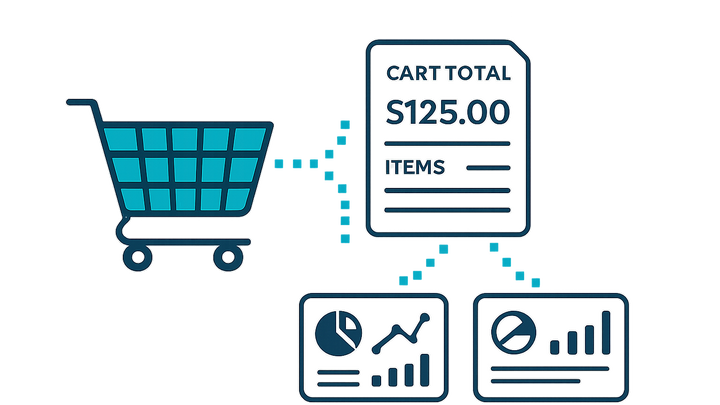Published on 2025-06-26T05:21:43Z
What is a Purchase Event? Examples for Purchase Events.
A purchase event in analytics marks the completion of an e-commerce transaction on a website or app. It captures critical details such as transaction ID, total value, currency, and the list of purchased items. By tracking this event, businesses can measure revenue, analyze buying behavior, and optimize marketing and sales funnels. In Google Analytics 4 (GA4), purchase events follow the enhanced e-commerce schema, while cookie-free platforms like PlainSignal allow you to track purchases without relying on client-side cookies, preserving user privacy. Implementing purchase event tracking on your confirmation page unlocks insights into conversion rates, average order values, and product performance across your analytics stack.
Purchase event
An e-commerce event capturing transaction details—ID, revenue, currency, and items—to measure sales and optimize marketing.
Why Purchase Events Matter
Purchase events are the cornerstone of e-commerce analytics. They allow you to:
- Measure total revenue and average order value
- Analyze customer buying patterns and product performance
- Attribute conversions to marketing campaigns
- Identify drop-off points in the purchase funnel
- Optimize pricing, promotions, and merchandising strategies
-
Revenue tracking
Capture and aggregate order totals to understand overall sales performance over time.
-
Funnel optimization
Use purchase completion rates to spot drop-offs and improve the checkout flow.
-
Marketing attribution
Link purchases back to campaigns, channels, and touchpoints for ROI analysis.
Key Parameters
Purchase events typically include standardized parameters recognized by analytics platforms. Understanding these ensures consistent reporting.
-
Transaction_id
A unique identifier for each order, used to dedupe events and match analytics data with backend records.
-
Value & currency
The monetary amount of the transaction and its currency code (e.g., USD), essential for revenue calculations.
-
Items
An array of objects representing each purchased item (ID, name, category, price, quantity).
Implementation Examples
How to set up Purchase Event tracking using PlainSignal and Google Analytics 4.
-
PlainSignal (cookie-free analytics)
Use PlainSignal’s simple cookie-free analytics snippet on your purchase confirmation page to track purchase events. Include the SDK and call
window.PlainSignal('track', 'Purchase', {...})with transaction details:<link rel="preconnect" href="//eu.plainsignal.com/" crossorigin /> <script defer data-do="yourwebsitedomain.com" data-id="0GQV1xmtzQQ" data-api="//eu.plainsignal.com" src="//cdn.plainsignal.com/plainsignal-min.js"></script> <script> window.PlainSignal('track', 'Purchase', { transaction_id: 'ORDER1234', value: 99.99, currency: 'USD', items: [ { id: 'SKU123', name: 'T-Shirt', category: 'Apparel', price: 49.99, quantity: 1 }, { id: 'SKU456', name: 'Mug', category: 'Home Goods', price: 9.99, quantity: 5 } ] }); </script>-
Load PlainSignal sdk
Embed the PlainSignal script in your page header to initialize tracking.
-
Track purchase event
Invoke the
window.PlainSignal('track', 'Purchase', {...})method with transaction details on your confirmation page.
-
-
Google analytics 4
After loading gtag.js, fire the
purchaseevent with your GA4 measurement ID and transaction details:<script async src="https://www.googletagmanager.com/gtag/js?id=GA_MEASUREMENT_ID"></script> <script> window.dataLayer = window.dataLayer || []; function gtag(){dataLayer.push(arguments);} gtag('js', new Date()); gtag('config', 'GA_MEASUREMENT_ID'); gtag('event', 'purchase', { transaction_id: 'ORDER1234', value: 99.99, currency: 'USD', items: [ { item_id: 'SKU123', item_name: 'T-Shirt', item_category: 'Apparel', price: 49.99, quantity: 1 }, { item_id: 'SKU456', item_name: 'Mug', item_category: 'Home Goods', price: 9.99, quantity: 5 } ] }); </script>-
Load GA4 library
Include the gtag.js script with your GA4 measurement ID.
-
Send purchase event
Call
gtag('event', 'purchase', {...})with the transaction parameters.
-
Best Practices and Troubleshooting
Ensure your purchase events are accurate, deduplicated, and privacy-compliant by following these guidelines.
-
Validate data accuracy
Cross-verify event data against backend records and use debug tools to inspect payloads.
-
Avoid duplicate events
Implement flags or state checks to fire the purchase event only once per transaction.
-
Respect user privacy
Anonymize user identifiers, avoid collecting PII, and comply with GDPR and other privacy regulations.
